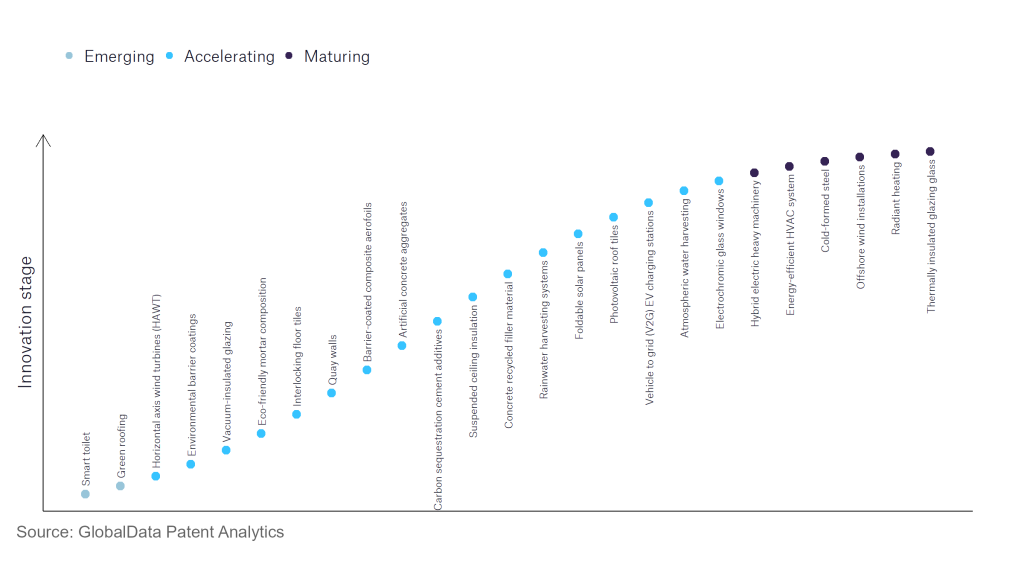The construction industry continues to be a hotbed of innovation, with activity driven by an increased focus on environmental sustainability and workplace safety, and the growing importance of technologies such as the Internet-of-Things (IoT) and robotics as well as higher quality construction products and materials. In the last three years alone, there have been over 248,000 patents filed and granted in the construction industry, according to GlobalData’s report on Environmental sustainability in Construction: Radiant heating. Buy the report here.
However, not all innovations are equal and nor do they follow a constant upward trend. Instead, their evolution takes the form of an S-shaped curve that reflects their typical lifecycle from early emergence to accelerating adoption, before finally stabilising and reaching maturity.
Identifying where a particular innovation is on this journey, especially those that are in the emerging and accelerating stages, is essential for understanding their current level of adoption and the likely future trajectory and impact they will have.
80+ innovations will shape the construction industry
According to GlobalData’s Technology Foresights, which plots the S-curve for the construction industry using innovation intensity models built on over 179,000 patents, there are 80+ innovation areas that will shape the future of the industry.
Within the emerging innovation stage, green roofing is a disruptive technology that is in the early stages of application and should be tracked closely. HAWT wind turbines, environmental barrier coatings, and vacuum-insulated glazing are some of the accelerating innovation areas, where adoption has been steadily increasing. Among maturing innovation areas are hybrid electric heavy machinery and energy-efficient HVAC system, which are now well established in the industry.
Innovation S-curve for environmental sustainability in the construction industry

Radiant heating is a key innovation area in environmental sustainability
Radiant heating refers to a heating system that uses infrared radiation to transfer heat directly from a warm surface, such as a floor or ceiling panel, to people and objects in the room. Instead of heating the air, as traditional forced-air heating systems do, radiant heating warms up the surfaces in a space, which in turn radiates heat to the surrounding environment. This method of heating provides a more even and comfortable distribution of heat throughout a room, while also reducing energy consumption and improving indoor air quality.
GlobalData’s analysis also uncovers the companies at the forefront of each innovation area and assesses the potential reach and impact of their patenting activity across different applications and geographies. According to GlobalData, there are 10+ companies, spanning technology vendors, established construction companies, and up-and-coming start-ups engaged in the development and application of radiant heating.
Key players in radiant heating – a disruptive innovation in the construction industry
‘Application diversity’ measures the number of different applications identified for each relevant patent and broadly splits companies into either ‘niche’ or ‘diversified’ innovators.
‘Geographic reach’ refers to the number of different countries each relevant patent is registered in and reflects the breadth of geographic application intended, ranging from ‘global’ to ‘local’.
Patent volumes related to radiant heating
| Company | Total patents (2021 - 2023) | Premium intelligence on the world's largest companies |
| Progress Profiles | 63 | Unlock Company Profile |
| REHAU | 38 | Unlock Company Profile |
| Viega | 20 | Unlock Company Profile |
| Genuit Group | 17 | Unlock Company Profile |
| Kingspan Group | 17 | Unlock Company Profile |
| Laing O'Rourke | 14 | Unlock Company Profile |
| LG | 12 | Unlock Company Profile |
| Mitsubishi Electric | 10 | Unlock Company Profile |
| Liaver | 8 | Unlock Company Profile |
| Gerflor | 8 | Unlock Company Profile |
| Royal BAM Group | 8 | Unlock Company Profile |
| FRITZ EGGER | 7 | Unlock Company Profile |
| Wacker Neuson | 6 | Unlock Company Profile |
| Uzin Utz | 6 | Unlock Company Profile |
| Daikin Industries | 6 | Unlock Company Profile |
| Veev Group | 5 | Unlock Company Profile |
| Aluminium Bahrain BSC | 5 | Unlock Company Profile |
| Sumitomo | 5 | Unlock Company Profile |
Source: GlobalData Patent Analytics
A leading patent filer in the radiant heating space is Progress Profiles. A recent innovation involves the utilisation of an underlayment system that includes a plurality of protrusions extending from a common base member. The protrusions and base member can include an opening that allows for subsequent layers of material, such as adhesive, to interact and bond with each other. The protrusions are arranged in such a way as to contain a wire, string, or heating element, within a receiving area. The arrangement of the protrusions also allows for the routing of the wire, string, or heating element in a variety of angles, bends, and other routing layouts. Other leading companies in the space include REHAU, Viega, and Kingspan.
In terms of application diversity, the leading companies are Laing O’Rourke, Liaver, and Veev, while in terms of geographic reach, the leading companies are Laing O’Rourke, Uzin Utz, and Liaver.
To further understand the key themes and technologies disrupting the construction industry, access GlobalData’s latest thematic research report on Construction.
Data Insights
From

The gold standard of business intelligence.
Blending expert knowledge with cutting-edge technology, GlobalData’s unrivalled proprietary data will enable you to decode what’s happening in your market. You can make better informed decisions and gain a future-proof advantage over your competitors.



